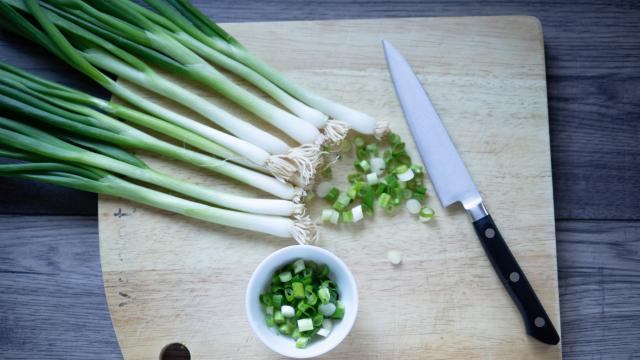I’m keen on green onions. The lazy “and the wise” man’s onion, spring onions are versatile, dirt cheap and easy to deal with, and they should be a staple in everyone’s kitchen, beyond their typical use a garnish.
For those who aren’t familiar, spring onions are young onions, harvested before the bulb has formed. In appearance, they resemble a midpoint between chives and leeks: Wispy, hollow stalks; thin and green at the tips; and progressively heartier and whiter in colour as you get down to the stem.
The green part is herbal and grassy with a hint of sweetness, with a nice crisp snap, while the white part is closer to a traditional onion, only softer and milder, with less bite.
Here’s why you should make spring onions an every day ingredient in your kitchen if they aren’t already.
They’re easy to work with and won’t make you cry
If you’re a lazy, moody home cook like me, any slightly laborious task, such as dicing an onion, can be enough to dissuade you from making a meal, opting instead for junk food from the deli, or overpriced delivery. But with green onions, you reap the same benefits as regular bulb onions, and then some, with much less hassle and absolutely no tears!
If I’m using the spring onions as a garnish, all I have to do is snip the green tips with a pair of scissors. If I want to use the more savoury, whiter part of the onion near the roots for a sauce or stew, I can use a paring knife to make quick and clean slices.
They’re versatile as hell
Their most popular use is as a garnish; you can sprinkle the thin green tips on top of almost any savoury food to excellent effect. As a general rule, they’re not going to do any harm, and they will add a little something in both taste and texture, meaning you don’t need to worry about overdoing it. But more than just an afterthought of a topping, spring onions can do the heavy lifting, serving as a key ingredient in the base for sautés, sauces and stews.
They can also hold their own as a vegetable side when roasted or grilled whole. Plus, they’re super cheap! A bundle of spring onions, roughly five to seven stalks bunched together, runs me $1 at my neighbourhood grocery store and can be used in so many different meals – more on that below.
Some ways to get started
Punch up a salad
Spring onions freshen up the flavour and add a little snap to any salad when you’re low on toppings. Starting with whatever lettuce looks freshest/won’t kill you, my friend Maddie makes a lovely all-green salad, adding roughly chopped pistachios and green onions, and tossing it with a variation on Goddess dressing that combines, lime, honey, olive oil and salt and pepper, resulting in the perfect combo of herbal, crunchy and tangy.
Sprinkle them on top of literally anything
Add them to baked potatoes, use them in sandwiches (they go well mixed into tuna or chicken salad), or toss them on some eggs, avocado toast, rice bowl or any Asian-inspired noodle dish, like these cold, spicy peanut noodles, or even your sad microwave ramen.
They enhance any dip or spread; there’s a reason spring onion cream cheese is the best kind of cream cheese. You can even use the roots in this manner, when well-washed and sautéed until crispy, to add an oomph to a homemade onion dip.
Sauté them instead of onions
The heartier, white part at the stem of the spring onion is best diced and sautéed as you would a traditional onion, and will work in its place if you don’t have one on hand. Add to the pan when you’re cooking up fried rice or a stir-fry, use as a savoury base before you braise meat or veggies, or add to ratchet up the flavour of homemade vegetable soup stock.
Combine the green and the white
Often, recipes call for both the green and white parts of the onion, take ginger-spring onion sauce, a magic mixture for dumplings, noodles, pretty much anything you fancy which combines sautéed minced ginger, vegetable oil, and a whole chopped spring onion.
A charred spring onion butter, made by mixing sautéed diced spring onion with lime zest, lime juice and butter, makes a creamy and tangy topping for fish or steak, and I’d argue green onions would do just fine as a substitute for shallots in a classic white wine lemon seafood sauce.
You can also cook the combination into the dough for spring onion pancakes; using it in leftover veggie pancakes that salvage any produce you have floating around your fridge; or baking them into cheddar and spring onion biscuits for an extra kick.
Roast or grill them whole
Spring onions can hold their own as a vegetable side dish when roasted or grilled whole. Treat them as you would asparagus, tossing with plenty of olive oil, salt and pepper, and lemon if you like. If you’re oven-roasting, opt for high heat, at least 200 – 230 degrees, cooked for about 20 minutes or until nicely wilted and browned.
If you’re grilling, Alex Delaney at Bon Appetit recommends first slicing your spring onions in half lengthwise, to ensure that maximum surface area comes in contact with the grill, which should be at high heat. From there, lay them right on the grates or place them in a basket (or in foil) and cook for five minutes, until blistered.
This article has been updated since its original publication.

Comments